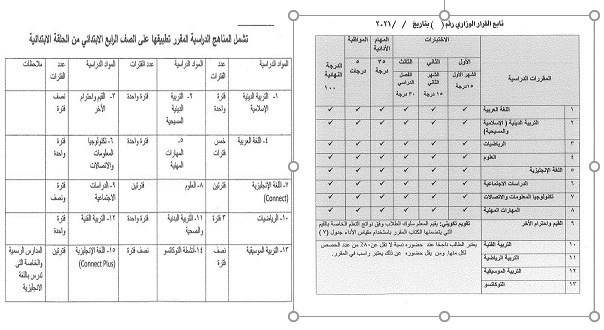The Minister of Education issues a ministerial decision regarding the education system, courses and assessment method for the fourth grade of primary school

Tariq Shawky, Minister of Education and Technical Education, issued Ministerial Decision No. 133 on 9-21-2021 regarding the education system, curricula and evaluation method for the fourth grade of primary school for the 2021/2022 school year.
The ministerial decision specified the study subjects to be applied to the fourth grade of primary school in general education schools: (official – official languages – and official distinguished languages – specific to both Arabic and languages), and the subjects are: (Arabic language, science, social studies, mathematics, and English (Connect). ), values and respect for others, “Islamic or Christian” religious education, vocational skills, information and communication technology, physical and health education, art education, music education, and tokatsu activities), as well as English (Connect Plus) for public schools. Especially taught in English.
He pointed out that with regard to the Arabic calligraphy booklet, it is printed for the academic year 2021/2022 as it is without any change.
On the assessment system and its tools, the ministerial decision stressed that the assessment system in the fourth grade of primary school will depend on measuring learning outcomes for the developed subjects, provided that the assessment result comes in the form of four colors that express the extent to which the learner has acquired knowledge and skills, where the blue color indicates that the learner has exceeded Expectations in acquiring knowledge and skills (85 to 100), the green color indicates that the learner has acquired the required knowledge and skills (from 65 to less than 85), the yellow color indicates that the learner needs some support (from 50 to less than 65), and the red color indicates The learner has not mastered these knowledge and skills and still needs a lot of support (from 1 to less than 50).
He continued: The assessment tools will be through:
1- Exams 2- Performing tasks 3- Attendance 4- Formative evaluation according to performance rates for the values and respect course 5- Achieving an attendance rate of no less than 80% for physical education, art education and music education.
As for the exams, the ministerial decision clarified that they are divided into three exams in one semester. The first test comes after the end of a month of study, and the second test targets the parts of the course that were taught in the second month. The last test is at the end of the semester. At the end of the semester, the student gets the sum of the three tests.
He added: The exams are applied three times in each semester. So that the first and second tests apply the target learning outcomes in the time period allocated to each of them separately (the first month and the second month of the semester), and the final exam on the learning outcomes for the entire semester.
Regarding the performance tasks, the decision confirmed that they measure the extent to which students acquire skills, and they provide evidence of achieving the targeted learning outcomes during the semester, as they represent short tasks that the learner can complete in a time of two lessons; The first lesson The teacher distributes to the students a number of tasks related to the course. The student chooses one of these tasks so that he finishes it in a time of two lessons in the class or school.
Regarding the mechanisms for evaluating the student’s success and his transition to the higher grade in one academic year, the ministerial decision identified several considerations, which are:
- The student's score in one academic course in the semester is calculated through the sum of the scores of the three tests, the performance tasks, and the attendance scores.
The total marks for all courses are equal, calculated out of 100 and given to the student in the form of colours.
Passing is calculated by calculating the arithmetic average of its total grades for each semester (the sum of the grades of the first semester + the sum of the grades of the second semester divided by 2) provided that the grades are converted into colors.
- Art, sports and music education A student is not considered successful unless he attends at least 80% of the number of classes in each of them.
Students of the second round are evaluated on what they studied in the two semesters through tests only.
- If the student continues to obtain the red color in one or more courses after the second round exams, he must repeat the school year again.
